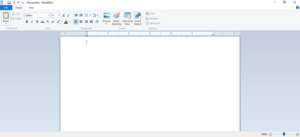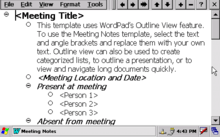WordPad
WordPad is a basic word processor that is included with almost all versions of Microsoft Windows from Windows 95 onwards. It is more advanced than Microsoft Notepad but simpler than Microsoft Word and the discontinued Microsoft Works. It replaced Microsoft Write.
 | |
| Developer(s) | Microsoft |
|---|---|
| Stable release | |
| Operating system | Windows 95 and higher |
| Predecessor | Microsoft Write |
| Type | Word processor |
Features
WordPad can format and print text, including fonts, bold, italic, colored, and centered text, etc., but lacks functions such as a spell checker, thesaurus, and control over pagination. It does not support footnotes or endnotes. WordPad can, however, read, render, and save many Rich Text Format (RTF) features that it cannot create, such as tables, strikeout, superscript, subscript, "extra" colors, text background colors, numbered lists, right or left indent, quasi-hypertext and URL linking, or various line spacing. Among its advantages are low system-resource usage, simplicity, and speed. Pasting into or from an HTML document such as from the internet or email will typically automatically convert most or all of it to RTF (although this is partially browser-dependent). As such, WordPad is well suited for taking notes, writing letters and stories, or for usage in various tablets, PCs, and smart phones. However, WordPad is underpowered for work that relies heavily on graphics or typesetting such as most publishing-industry requirements for rendering final hard copy.
A character not on the keyboard can be entered into Wordpad by typing its hexadecimal code point in Unicode followed by Alt+X. Likewise, the code point of a character from another application can be determined by copying it into Wordpad followed by Alt+X.
WordPad natively supports RTF, though it does not support all the features defined in the RTF/Word 2007 specification. Previous versions of WordPad also supported the "Word for Windows 6.0" format, which is forward compatible with the Microsoft Word format.
In Windows 95, 98 and Windows 2000, it used Microsoft's RichEdit control, versions 1.0, 2.0 and 3.0 respectively.[2] In Windows XP SP1 and later, it uses RichEdit 4.1,[3] including Windows 7.[4]
WordPad for Windows XP added full Unicode support, enabling WordPad to support multiple languages, but UTF-16/UCS-2 Big Endian is not supported. It can open Microsoft Word (versions 6.0-2003) files, although it opens newer versions of the .DOC format with incorrect formatting. Also, unlike previous WordPad versions, it cannot save files in the .doc format (only .txt or .rtf). Files saved as Unicode text are encoded as UTF-16 LE. Windows XP Service Pack 2 onwards reduced support for opening .WRI files for security purposes.

Windows XP Tablet PC Edition SP2 and Windows Vista include speech recognition, and therefore dictation into WordPad is possible. In these and later Windows versions, the RichEdit control was added and as a result, WordPad now supports extensible third-party services (such as grammar and spell check) built using the Text Services Framework (TSF).[5]
In Windows Vista, support for reading Microsoft Word DOC files was removed because of the incorrect rendering and formatting problems, as well as a Microsoft security bulletin that reported a security vulnerability in opening Word files in WordPad.[6] For viewing older (97-2003) as well as newer (Office Open XML) documents, Microsoft recommends Word Viewer, which is available free. Native Office Open XML and ODF support was released in the Windows 7 version of WordPad.[7][8]
In Windows 7, the program's user interface was updated to use a ribbon toolbar, similarly to Microsoft Office.[9]
In a 2020 insider build of Windows 10, WordPad is modified to include advertising notifications for the Office web apps as an alternative.[10]
History
WordPad was introduced in Windows 95, replacing Microsoft Write, which came with all previous versions of Windows (version 3.11 and earlier). The source code to WordPad was also distributed by Microsoft as a Microsoft Foundation Classes sample application with MFC 3.2 and later, shortly before the release of Windows 95. It is still available for download from the MSDN website.[11]
The default font used in Windows 95 to Windows Vista was Arial 10; in Windows 7 it was changed to Calibri 11.
A similar word processor, also called WordPad, is supplied by some vendors on a Windows CE pre-installation.[12] It has simple functionality like its desktop OS cousin. The icon resembles an early Microsoft Word icon.
See also
- Jarte – a word processor for users of Microsoft Windows, based on the WordPad engine.
- List of word processors
- Comparison of word processors
References
- "June 18, 2020—KB4567523 (OS Build 19041.331)". Microsoft Support. 18 June 2020. Retrieved 18 June 2020.
- "RichEdit Versions 1.0 through 3.0 – Murray Sargent: Math in Office". Blogs.msdn.com. 12 January 2010. Archived from the original on 18 January 2010. Retrieved 10 January 2017.
- "RichEdit versions – Murray Sargent: Math in Office". Blogs.msdn.com. 13 October 2006. Archived from the original on 23 January 2010. Retrieved 10 January 2017.
- "WordPad Numbering Limit – Murray Sargent: Math in Office". Blogs.msdn.com. 19 June 2009. Archived from the original on 20 June 2009. Retrieved 10 January 2017.
- "Enabling Text Correction for Custom Ink Collectors (Windows)". Msdn2.microsoft.com. 26 December 2016. Archived from the original on 13 September 2007. Retrieved 10 January 2017.
- "Microsoft Security Bulletin MS09-010 - Critical". Microsoft.com. Archived from the original on 1 September 2009. Retrieved 10 January 2017.
- "Windows 7: The Top 10 Hidden Features". PC Magazine. Ziff Davis. 30 September 2010. Archived from the original on 11 April 2013. Retrieved 3 April 2013.
- "Using WordPad". Windows portal. Microsoft. Archived from the original on 28 March 2013. Retrieved 3 April 2013.
- Thurrott, Paul (6 October 2010). "Windows 7 Feature Focus: Scenic Ribbon, Paint and WordPad". Supersite for Windows. Penton Media. Archived from the original on 13 March 2013. Retrieved 3 April 2013.
- "Microsoft is Testing Ads in Wordpad You Might Actually Be Glad to See -". ExtremeTech. Retrieved 22 January 2020.
- "WORDPAD Sample: The Windows Application". Msdn2.microsoft.com. 26 December 2016. Archived from the original on 29 April 2007. Retrieved 10 January 2017.
- WordPad (Compact 7) | Microsoft Docs